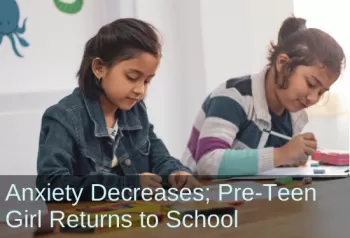Primitive Reflex Integration Case Studies
6 Months Makes a Huge Difference: Pre-Teen Girl's Anxiety Decreases, Achieves Big Jump in Standardized Test Scores
Reflex integration helps with regulation, learning challenges, and speech
This pre-teen struggled academically, and severe anxiety led to her being pulled out of school. Her occupational therapist provided rhythmic movements and reflex integration, and her standardized reading scores jumped from 5% to 90%. Her anxiety reduced so much that she wanted to return to school, and her speech improved enough that she graduated from therapy.
Submitted by Rae, OT

| Before | After |
|---|---|
| Pulled out of school because of chronic anxiety | Returned to school and is now enjoying it |
| Standardized test scores for reading and language comprehension was at 5% | Standardized test scores for reading and language comprehension jumped to 90% |
| Struggled with math | Math skills increased by several grades |
| Attended Speech Therapy | Graduated from Speech Therapy |
Allison is an 11-year-old girl who had been recently diagnosed with Autism. She was taken to a Neurodevelopmental Specialist after her mother removed her from public middle school 6th grade. Allison’s mother chose to home school Allison when her chronic anxiety began to impact her home life and health. Allison has always struggled socially, has been slow to catch on and to fit in with others. However, it was now very clearly impacting her mental and physical health.
Allison’s mom did not think that her daughter had Autism. She said it just ‘did not seem to fit”. Her mother described Allison’s participation in middle school, “It seems like she doesn’t get what is going on or why”. Allison did not comprehend changing classes, preparing for the next class or how eat lunch in the cafeteria.
When Allison and her mother came for the initial evaluation, she was exceptionally subdued and disconnected. She had trouble answering any question and tended to agree with everything with a mumbled ‘mmm, yeah…’ and would keep her eyes down. I asked her to draw a picture of something she liked to do, and she drew a very basic line drawing of a person swimming in a swimming lane.
I felt rhythmic movements [from the Brain and Sensory Foundations course] would help to get her brain stem to calm down. I performed each movement asking “faster, slower or just right”, to do it for “one minute or ten minutes” and she easily was able to state the speeds and duration that she wanted. Each movement was performed for several minutes apiece. Allison made the following comments: This feels like I am in water. This feels so relaxing. I really like this. Her face began to relax and smile. I gave her another piece of paper and asked to draw another picture while I talked with her mother about the nuances of performing the exercises at home. Allison’s second picture had her name written large in the middle of the paper with a picture of a cheery house, a shining smiling sun and large green trees! So different from the first one!
During one of our last sessions we did the 5-Step Balance [from the Brain and Sensory Foundations course]. She didn’t have alot of words to describe her experience of the process, but she was smiling more when we finished the session.
I saw Allison for 12 sessions for 30 minutes each over the course of 6 months. During sessions we performed Rhythmic movements and different primitive reflexes [from the Brain and Sensory Foundations course]. Each session included physical and emotional play and then active reflex integration tasks including Moro, Fear Paralysis Reflex and TLR [Tonic Labyrinthine Reflex].
Allison performed activities and exercises at home ‘more days than not’. She was able to complete AROM rhythmic movements and isometric activities to assist with PRI [Primitive Reflex Integration].
During our time, standardized testing at the school demonstrated her reading and language comprehension went from the 5% to the 90%, her math skills increased by several grades and she was working on fractions, and she even graduated from Speech Therapy!
The largest qualitative marker to let us know it was time for discharge was when Allison told her mom she would like to try middle school again next year.
(Edited, emphasis added)
*Disclaimer: The activities in the Brain and Sensory Foundations curriculum make use of the natural processes of neuroplasticity and development that are innately wired in the design of human beings to promote maturity and function. These activities appear to calm, organize, and mature the neuro-sensory-motor systems just as we see in the healthy development of human infants. Individual results may vary, and we do not claim to offer a diagnosis or cure for any specific condition or disorder. The Brain and Sensory Foundations activities appear to improve overall functioning resulting in measurable improvements for a range of conditions as demonstrated in over 1800 case studies from participants.

